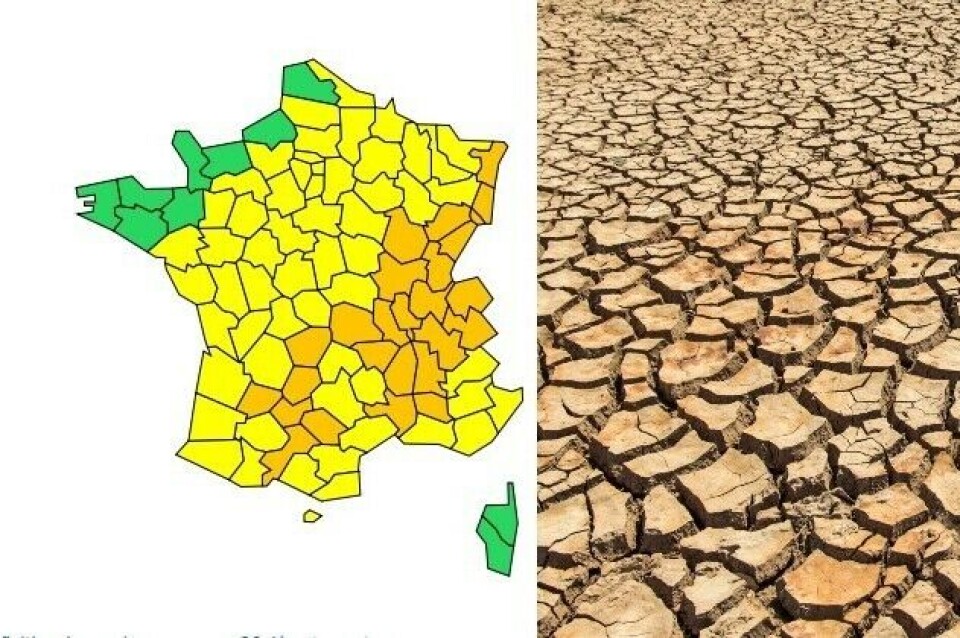-
Britons are the largest foreign community of second-home owners in Nouvelle Aquitaine
See which other departments in the region are popular with British nationals
-
Travellers risk extra costs under new Eurotunnel ticket rule
Some fare options are less flexible and less forgiving of lateness
-
May will be difficult month for train travel in France, warns minister
Two major train unions are threatening to strike and are ‘not willing to negotiate’, he says
60 French departments have ‘crisis’ drought alerts as heat continues
A nuclear power station faces temporary closure due to the heat with highs of up to 40C expected today before the heatwave abates.

There are now 60 French departments where one or more communes are under a ‘crisis’ drought alert, resulting in the highest level of restrictions, as this week’s heatwave continues.
Read more: Vigilance, alert, crisis: what France’s four drought warnings mean
Some 26 departments are under an orange canicule heatwave warning today (August 4),
The heat is exacerbating drought concerns in France, and yesterday (August 3) the ecological transition ministry added two departments – Haut-Rhin and Lozère – to the list of departments which have crisis level alerts in place.
The crisis alert will likely not apply to the whole department, but rather to specific communes. You can find out more on the government’s Propluvia website.
Paris’ mairie has also called for residents to “pay attention” to the amount of water they are using, as the capital and its surrounding departments are placed on a ‘vigilance’ warning, under which the population is encouraged to reduce their consumption.
“The first thing is to not water your plants during the day, the second is to not leave the tap running as you wash yourself, but to rinse quickly [instead], to be aware of each time you use water.
“Finally, [you should make sure] your washing machine or dishwasher is full before switching it on,” Anne Souyris from the mairie de Paris has said.
The local authority, for its part, has started watering its parks and green spaces at night rather than during the day.
Haute-Corse’s prefecture has urged people to reduce their consumption in order to avoid “a serious crisis,” adding: “At this rate [...] considering the weather conditions expected, there will not be any more water within 25 days.”
France had already experienced a dry winter and spring, but July 2022 was the driest since 1959, with a rainfall deficit of 84%, according to Météo France.
“We are in a record drought situation in terms of ground moisture across the country as of July 17,” Météo France climatologist Jean-Michel Soubeyroux has said. The soil is drier currently than it was at the same time in 1976 and in 2003.
What does a crisis alert entail?
There are four levels of drought warning and alert in France: ‘vigilance’, ‘alerte’, ‘alerte renforcée’ and ‘crise’.
Crise (crisis) level is applied when the three previous levels are not sufficient to manage the situation.
The following measures apply at this level:
- Water use is only permitted for necessary means, including for drinking, health, civil security, cleaning
- Ban on watering gardens or green spaces. There are sometimes exceptions for trees, bushes and vegetable gardens within certain hours
- Stricter limits on watering golf courses, for example it will only be permitted during the night
- Ban on watering sports fields, except in the case of elite competition
- Ban on washing cars
- Ban on filling or emptying private swimming pools
- The local health authorities will decide whether public swimming pools can be filled / drained
- Ban on water usage for most agricultural practices
The mayors of individual communes may adjust the above rules depending on the situation, so you should check with your local mairie for more precise details.
What is expected to happen with the heatwave?
Yesterday was the hottest day of the current heatwave episode, although the high temperatures continue today.
The departments placed under orange heatwave alert are: Haute-Garonne, Tarn, Tarn-et-Garonne, Lot-et-Garonne, Lot, Corrèze, Puy-de-Dôme, Haute-Loire, Ardèche, Gard, Vaucluse, Drôme, Isère, Savoie, Haute-Savoie, Ain, Loire, Rhône, Saône-et-Loire, Jura, Doubs, Haut-Rhin, Bas-Rhin, Territoire de Belfort, Haute-Saône and Côte-d’Or.
There are also 60 departments under a yellow heatwave warning, covering all but the far north west and Corsica.
The heat is expected to abate slightly tomorrow (August 5), as the hot air mass moves eastwards.
“Between Wednesday and Thursday, maximum temperatures will often be above 35C, with spikes of 39-40C in the south west,” Météo France has said.
At 17:00 yesterday, Belin-Beliet in Gironde recorded a temperature of 39.6C. It was also 38C in Toulouse and Lyon, 37C in Grenoble, 36C in Strasbourg and 35C in Paris and Nantes.
Consequences across the country
The heat and dryness have impacted various activities across France. EDF, for example, has warned of the possibility of “restrictions” to production at its nuclear plant in Tricastin (Drôme), because of “high forecasted temperatures around the Rhône”, whose water is used to cool the reactors.
Several rivers and canals have also been closed or partially restricted as the water level drops.
Read more: Parts of French canals closed to boats due to low water level
People fishing in the Garonne around Toulouse have had to move out to the middle of the river bed to be able to find anything, and in Bordeaux river cruises to the vineyards further upstream have been cancelled.
“We cannot see an exit from this drought situation in the immediate future,” Mr Soubeyroux said. “We would need a month of excess rainfall to return to a normal situation.”
Related articles
Drought map update: See the French departments with water restrictions
French homes subject to drought rule checks
South-west France residents cannot water gardens for three months
























